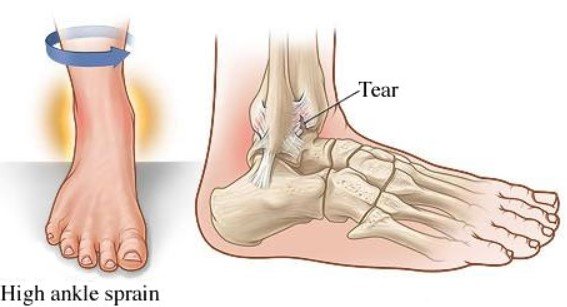Ankle Sprain | Strain
What is an Ankle Sprain?
Simply put, an ankle sprain is when the ligaments of the ankle are stretched past their end-range (or limit). This is typically caused by a rapid stretch to the ligament which can result in tearing, swelling, bruising, inflammation and discomfort.
Ankle Sprain Grades:
Ankle sprain severity ranges from grades 1-3.
Grade 1: small, microtears - typically recover quickly
Grade 2: partial tearing of the ligament
Grade 3: complete tear of the ligament - may or may not require surgical intervention
When to Xray Ankle Sprain?
Short answer? ALWAYS. We want to look at both the bones of the foot AND the bones of the lower leg/ankle so ensure that no other structures are involved. This can significantly change treatment recommendations!
Which Ankle Sprain is Most Common?
An inversion ankle sprain (also known as a Lateral Ankle Sprain) is most common at 90% of most ankle sprains. We have twice as much range of motion rotating the foot in towards the center of our body (inversion) than we do with rotating the foot out and away from our body (eversion). The ligament that is most commonly sprained is the Anterior TaloFibular Ligament (aka: ATFL) because it sits on the outside of the ankle.
What's a High Ankle Sprain?
A high ankle sprain is a sprain within the Anterior Tibial Fibular Ligament. This ligament keeps the two bones of the lower leg (tibia and fibula) in relationship to one another. This relationship helps to allow you to raise and lower the foot- pretty important in everyday functioning! To determine if there is damage to this ligament, you can simply squeeze the tibia and fibula together above the top of the ankle to try to elicit pain. This could be a surgical case if there is a tear and should be addressed by a professional.
When To Tape Ankle Sprain | Rock Tape:
Using RockTape on an ankle sprain immediately following an injury can help with swelling - see this technique. It can also be helpful with recovery to help bring awareness to the area as well- see this technique. It WILL NOT however, create immobilization or stability for the joint as it is flexible tape and does not restrict range of motion.
How to Treat a Mild Ankle Sprain:
Bracing (VERY short-term) with non-threatening mobilization is generally recommended. Key points to working on ankle rehabilitation:
Light myofascial release/massage to the ankle AND the bottom of the foot, dry brushing and/or Rock Tape to increase blood flow and lymphatic movement
Non threatening joint mobilization & mobilization to the talus has shown to decrease pain- this can be done by a Chiro or at-home with bands
Balance | proprioception (body’s awareness of its position in space)- balance boards with the foot in specific positions and barefoot, walking on different textures and environments such as barefoot on unstable surfaces
Stability training- single leg work with eyes open and eyes closed and looking at inner foot muscles, core and hips
Long term- looking to increase proprioception (body awareness), reaction time and the firing of supporting musculature of the ankle
Can Ankle Sprains Cause Knee Pain?
If the response to a sprain is to brace and reduce range of motion as much as possible (bracing, heel cups and high-top shoes) to decrease the chances of re-injury, it is important to work on range of motion outside of activity. If not, and we lose range of motion in the ankle joint, we are more likely to take on that motion elsewhere such as in the knee and increase chances of injury elsewhere. Take range of motion away from one area and another area is going to take on the additional stress. Loss of stability at the ankle can also create dysfunction in the knee as well which is why it is so important to address the foot & ankle, but up the chain in areas that can be affected as well such as in the knee, pelvis and core.
Why Does a Sprained Ankle Hurt at Night?
If your ankle is placed in the same position as it was during the time of injury, it can further stress the damaged ligaments and create pain/discomfort. The added weight of sheets and blankets can further place the foot into the irritating position and increase discomfort. There is also less sensation that your body has to process at rest so it is easier to focus on areas of discomfort. A brace at night can help reduce swelling and pain by keeping the foot & ankle out of a poor position with additional weight on top of it. As always, if there’s immobilization occuring, it’s important to then introduce a non-threatening mobilization to ensure that range of motion is not lost.
Are You More Likely to Sprain Your Ankle During Pregnancy?
During the pregnancy and postpartum periods a lot is changing! During pregnancy, there is an increase in laxity within the ligaments of the entire body, but the feet are especially susceptible as mom’s center of gravity changes due to the forward weight displacement of belly and breast tissue. Because of this, the foot is loaded differently and the arch (stability structure of the foot) is decreased slightly. There is also less stability from the stabilizer muscles of the pelvis such as glutes and core as they are impacted by the change in biomechanics as well. Mommas tend to be slightly more unstable when it comes to balance due to these changes. All of these components could, theoretically, contribute to an increased risk of ankle sprains during pregnancy. However, in 10 years of practice, I have not seen a dramatic relationship between pregnancy and increased ankle sprains. It’s more common to see increased tension patterns due to an effort to stabilize structures that tend to have more flexibility than what is typical.



